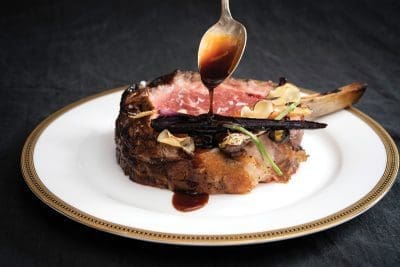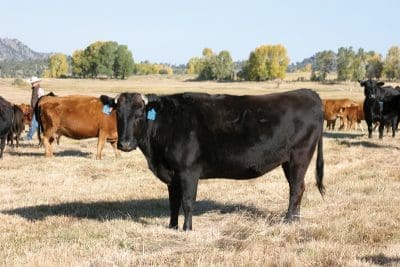Combining a Guest Ranch and a Working Cattle Ranch for Fun and Profit
By Burt Rutherford, Contributing Editor
Is it a guest ranch that runs cattle? Or is it a cattle ranch that welcomes guests to its world-class accommodations, activities and restaurants? With Brush Creek Ranch, it’s both. And the two are intertwined in a way that makes the operation truly unique.
Located near Saratoga, Wyo., Brush Creek Ranch offers guests a remarkable array of outdoor activities year ‘round. Its four restaurants offer world-class cuisine and, true to its working ranch roots, every menu – breakfast, lunch and supper – tempts guests with beef.

Not just any beef, however. The beef that guests enjoy is as unique as the experiences they enjoy. That’s because the Wagyu cattle that provide the ranch’s mainstay menu item are raised on the ranch. And the beef those cattle provide is every bit as unique in its own right.
Wagyu, once an oddity in the mainstream U.S. commercial cattle business, are now gaining rapid acceptance. Perhaps best known for the Kobe beef in Japan, Wagyu isn’t a breed. The name Wagyu refers to all Japanese beef cattle. “Wa” means Japanese and “gyu” means cow.
In fact, there are four different individual breeds of Wagyu cattle in Japan. Of those, only the Japanese Black and Japanese Brown, or Akaushi, are found outside of Japan. Both breeds roam the pastures of Brush Creek Ranch.
According to Ranch Manager Ron Hawkins, the cattle are docile and produce the Wagyu beef that guests enjoy at the restaurants for its flavor and tenderness.
Brush Creek Ranch has been a cattle/people business for seven years, and Hawkins says they’re still making adjustments on finding the sweet spot for carcass weights. “But I think we’re going to try somewhere between 1,600 and 1,800 pounds out of the feedlot.”
Once the primals hit the fabrication table at the ranch, they’ll yield as many as 60 different cuts per side that the chefs can prepare and serve to guests. Typically in the United States, about 50 percent of a beef carcass is ground and served as hamburger. Not so in Japan with Wagyu beef, says Kenichi “Ken” Katoh, a popular butcher and restaurateur in Japan.
Brush Creek Ranch invited Katoh to work with its chefs to understand how to fully utilize the 60 different cuts that a Wagyu carcass can yield per side. Because of the high marbling and exceptional tenderness inherent in Wagyu genetics, even cuts like the shank can be prepared so that a guest can enjoy a memorable dining experience.
In Japan, where hamburgers aren’t as popular as in the U.S, Katoh can fabricate a Wagyu carcass so that he only gets about 50 pounds of trimmings that will be ground. The United States, however, is a hamburger nation and while guests come to Brush Creek Ranch expecting a great outdoor experience and world-class dining, they still want a hamburger now and then.
So the Wagyu beef that is fabricated on the ranch isn’t cut exactly as it would be in Japan under the expert knives of Katoh and his butchers.
“But our chefs will take big primals and they’ll start taking that meat in a different way,” Hawkins says, “utilizing a lot of different cuts that aren’t normally used.”
The answer to providing guests with an exceptional dining experience when a cheeseburger is the choice is to mix the outside fat that’s trimmed off the carcass with the ground beef, Katoh says. “So the flavor and the fragrance comes from the Wagyu fat.”
Like Brush Creek Ranch, nearly all Wagyu beef producers in the United States sell their beef in a farm-to-fork production system. And once a person tastes Wagyu beef, the differences between it and the beef they buy at the grocery store or even enjoy in a white tablecloth restaurant is obvious. Expanding the grading system in the United States will help consumers and Wagyu beef producers alike better define the product.
In Japan, Wagyu carcasses are graded A1 to A5, with the top A5 grade showing an exceptional amount of marbling. As Japanese taste preferences change, the A5 grade is becoming less and less in demand, Katoh says. But using the Japanese grading system as a benchmark, the goal is to develop grades above the top limit of Prime that accurately indicate the amount of marbling and thus the dining experience that consumers can expect from Wagyu beef.
Japanese grading shows amount of marbling, but doesn’t indicate taste nor fragrance of the meat, Katoh says. “Brush Creek Ranch has been using Japanese grading as a benchmark, and they are going up to the next level. They are focusing on taste and fragrance of their beef, including intramuscular fat,” Katoh says. “In the next few years, when guests eat Brush Creek Ranch Wagyu beef, they will be able to taste and understand the legacy, heritage and philosophy of the ranch.
“We have enough knowledge and skills based on science to create the taste and fragrance in meat that we want. The challenge is to find out what taste and fragrance beef producers want to create. This idea is one of the most important challenges for our industry and Brush Creek Ranch will be a leader.”
Back at the Ranch
The ranch uses cutting-edge reproductive technology but respects the traditions of the western cattle business.
“We still do everything on horseback,” Hawkins says. “We try to move them with as little impact on the ground as we can, and horseback is the best way to do that.”
Hawkins and his crew stress the importance of low-stress handling. That’s because it’s a ranch-to-restaurant production system. “Keeping them from birth to slaughter at a very low-stress level is very important,” he says.
However, the cows aren’t coddled; calving season starts in April for the first-calf heifers and May for the cows, and the cows calve in the sagebrush. Cowboys ride the cows daily; newborn calves get tagged and receive a prebiotic drench.
When branding time rolls around, the calves get a seven-way vaccine and a squirt of Nasalgen. In addition, the calves are dehorned and bull calves are knife cut.
“Then, typically, three weeks or a month before weaning, we’ll give them a Vira Shield 6 and another seven-way and an oral wormer,” says Jake Keller, who handles the day-to-day cattle management. The calves get another dose of a prebiotic both at branding and preconditioning, he adds, “just to help get their guts working efficiently in times of stress.”
The calves also have access to creep feeders while still on the cow to help teach them to eat from a feeder and help them grow and respond well to the vaccination program.
“We’re retaining ownership all the way through,” Keller says. “We can’t afford to lose one to a late-term death, so we keep an eye on making sure they’re all healthy.”
The calves wean at 400 to 450 pounds, Hawkins says, then are backgrounded and put on feed. Wagyu are slower growing than British and Continental breeds, so they’ll stay on feed for around a year before being harvested.
At the moment, the ranch runs around 250 mother cows consisting of purebred Wagyu along with Red Angus and F2 Akaushi as embryo transfer recipients.
“We’re AI’ing all the Blacks and some of the Akaushi [and using natural service on the rest] and then use Black bulls for clean up,” Keller says.
Future plans call for some of the top-end bull and heifer calves to be grown and sold to other beef producers. Of the 2021 calf crop, 42 heifers were held back as replacements. The rest are on feed and will be custom harvested.
Down the road, Hawkins says they’d like to grow the cow herd. The portion of Brush Creek Ranch where the cows roam could handle as many as 500 head, but Hawkins is dedicated to conservative stocking rates and improving soil health in the pastures and hay meadows. “So around 300 to 350 is probably the sweet spot,” he says.
With that many, the ranch will be able to sell Wagyu beef beyond the ranch gate. “That’s certainly our goal,” he says, “once we start producing enough cattle to get an outside niche market.
“And I’ve always felt we’ve got a really good base just by reaching out to all of our past guests.” After all, they already know how good the beef is.
Beyond expanding the cow herd, Hawkins says they’re working toward a fully in-house production system.
“We hope to soon be feeding our own cattle on the ranch and harvesting our own cattle on the ranch once we get the system down. We’ve built barns that simulate what we saw in Japan and, that way, we can keep them climate controlled rather than in an outdoor facility. We can feed these cattle with a lot less temperature fluctuations.”
Temperature fluctuations in south-central Wyoming are simply part of the equation. Temperatures can range from 90° F in the summer to -20° F in the winter.
When provided good hay and a protein supplement, the cows handle those swings very well, Keller says. “They need more protein in the winter, and it took us a couple of years to learn that.”
In a confined feeding situation where pounds matter and the cattle are on feed for around a year, an indoor, temperature-controlled system makes a lot of sense. Especially when the goal is to produce a dining experience that a guest will brag about back home.
In addition to premium beef, the ranch also has a herd of dairy goats, several greenhouses and a distillery. The goat milk produces several varieties of artisanal cheeses for the guests to enjoy, and the greenhouses produce fresh vegetables and edible flowers that the chefs use in season. The distillery produces Brush Creek Ranch bourbon and gin. These efforts help the ranch be more sustainable by producing as much food as possible in a closed-loop system.
Beyond the ranch gate, Hawkins and others at Brush Creek Ranch are working with the U.S. Department of Agriculture and Colorado State University to develop or expand the current grading system to accommodate the growing number of Wagyu carcass.
“We have 98 percent of our cattle grade Prime,” Hawkins says. “But they’re beyond what the top limit of what Prime is to a grader. So we need to come up with something so we can educate the public, so they understand what this grading system means to them on their plate at home.”
Being in the people business and in a primarily closed-loop beef production business adds another level of challenge to running a ranch, Hawkins admits. But when it all comes together, it’s very rewarding. Given consumer trends, it’s not uncommon for guests to ask if the cattle are humanely raised and taken care of their whole life, Keller says.
“So that’s what we strive to do,” he says. And occasionally a guest will ask to tour the ranching operation. “I’ll drive them around and show them what they want to see. We have nothing to hide; I’ll absolutely tell them exactly what we’re doing.”
What’s more, Hawkins and Keller sit down with the restaurant wait staff and explain the ranch’s program. “So at least they have that knowledge so they can pass on the very basics to a guest sitting at a table.”






